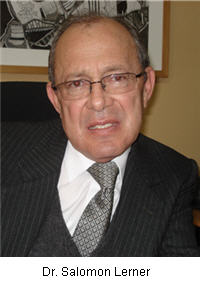A month ago his two pet Labradors were killed with poison. Later, he received anonymous phone calls warning that “what we did to your dogs we are going to do to you.” The phone calls have increased and, last week, he made the threats public.
Salomon Lerner, rector emeritus of Peru’s Pontifical Catholic University and president of the university’s Democracy and Human Rights Institute, has been the brunt of threats for almost 10 years, but now they are more direct, more personal.

The threats began when he became president in 2001 of the Truth and Reconciliation Commission, CVR. The threats escalated after August 2003 when the commission presented its final report on the internal conflict that took close to 70,000 lives between 1980 and 2000.
Support for Lerner was immediate through editorials, public letters, and columns, including by novelist Alonso Cueto, and journalist and former minister of Interior, Fernando Rospigliosi.
Peru’s Public Ombudsman, Beatriz Merino, urged the Ministry of the Interior to guarantee Lerner’s safety, and Americas Watch on Human Rights has called on Peru’s government to investigate the threats immediately.
“This kind of threat against leading defenders of human rights, such as Dr. Lerner, could have an intimidating impact on the Peruvian human rights community,” said José Miguel Vivanco, executive director of the Washington-based Americas Watch.
When asked if he had received any support from the Catholic Church, the soft-spoken Lerner told Caretas magazine, “I’m surprised I haven’t received the solidarity of the Grand Chancellor of my university,” referring to Monsignor Juan Luis Cipriani, archbishop of Lima and cardinal of Peru, who is an outspoken critic of the CVR report and was closely allied to the military when he was bishop of Ayacucho during the conflict.
According to Lerner, it would appear that the threats come from “right-wing fascistoids,” he believes mostly bloggers, although some of the tabloid press often echo the attacks. Early this year his biography on Wikipedia was altered to describe him as an ally of terrorists, and when he corrected the text, it was changed again, he told Caretas.
Although it is now six years since the nine tomes of the CVR report were published, and despite the fact that two years of investigations, hearings and testimonies found that Sendero Luminoso was responsible for more than half the deaths, the military and the political parties governing the country during the 20 years of conflict, including APRA, have been unwilling to accept the conclusions.
Today, the controversy continues as human rights cases grind slowly through the justice system and forensic research unearths more evidence, such as of the Putis massacre in Ayacucho, in which 123 men, women and children were shot and buried in a trench by military troops who then sold off the villagers’ cattle and pocketed the money. The case was documented in the CVR report, but the remains were only found in 2008.
Besides heading the Democracy and Human Rights Institute, Lerner is vice-president of the government-appointed commission in charge of building the Museo de la Memoria, a project which broadens the original photographic and audiovisual exhibition (Yuyanapaq: To Remember) set up by the CVR in 2003, which is to include more details and more from the military’s experience in the conflict.
The Memory Museum project developed from the need of the CVR exhibition, currently housed in the Museo de la Nacion, to find a permanent home. The military demanded more say in the project and the government dragged its feet on funding it until the commission’s president, novelist Mario Vargas Llosa, visited President Garcia personally to convince him of the need to complete the museum by mid-2011, before a new government is elected.





